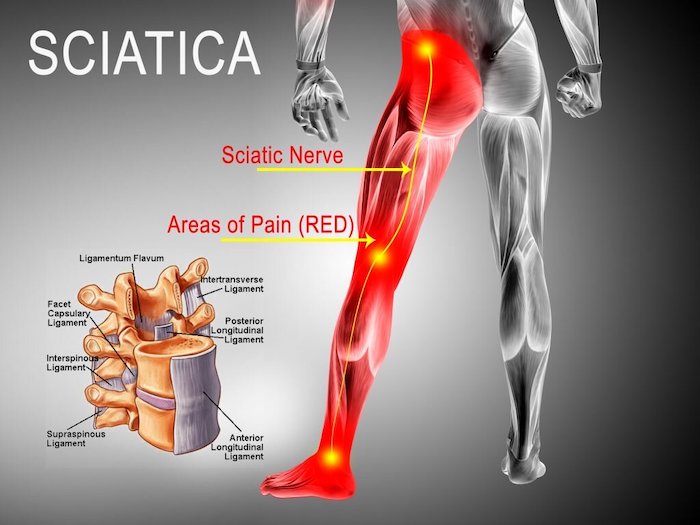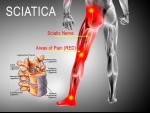
Pain Associated with The Sciatic Nerve Which Runs from The Lower Back, Down the Back of The Legs to The Feet
Pain and numbness run from the lower back or buttocks and down the back of the leg. Sciatica can affect both sides of the body or just one side.
Causes
Don’t be fooled by the term, “sciatica” most often does not involve damage to the sciatic nerve. Rather, the pattern of pain in the back of the leg is most often caused by irritation of the spinal nerves. The spinal nerves can be compressed by narrowing in the spine, known as lumbar stenosis, or inflamed by disc material that has bulged or herniated near the nerve, known as a disc herniation.
On rare occasions, the large nerve in the buttocks and back of the thigh called the sciatic nerve can be compressed by such conditions as piriformis syndrome or a pelvic tumor.
Symptoms
The most common symptoms of sciatica are radiating pain, numbness, or tingling from the low back or buttocks, down the back of the leg. Pain can be consistent or intermittent and can range from a dull ache to sharp and excruciating. Some patients report muscle weakness in the affected leg or foot. Sitting for long periods of time may aggravate the symptoms.
Concerning signs that require immediate attention include difficulty controlling the bowels or bladder, lack of sensation in the pelvis, or weakness in the leg that keeps getting worse. If any of these concerning signs are present then medical attention must be sought immediately.
Diagnosis
Sciatica can be caused by several conditions. To develop the most effective treatment plan, our pain specialist physician will:
- Collect a medical history and perform a physical exam to assess pain pattern and/or presence of muscle weakness.
- Consider X-rays, CT scans, or an MRI to determine if structural issues such as a herniated disc, spinal stenosis (narrowing), or pelvis lesion may be the cause of the pain.
- Evaluate the need for a special test, known as discography, which examines the internal structure of your spinal discs to determine the exact source of your pain.
- Assess for risk factors such as increased age, obesity, and sedentary lifestyles.
The type and extent of treatment depend on the cause of your pain (diagnosis) and other factors such as age, activity level, overall health, and severity of the condition.
Treatments
Mild cases of sciatica usually resolve themselves with simple interventions such as heat and/or ice packs and non-prescription anti-inflammatories. Some patients may also find relief through acupuncture, massage, or chiropractic manipulation. Physical therapy can strengthen and stretch the muscles in the pelvis and back and improve flexibility and posture. Prescription medications, either by mouth, or placed upon the skin, can reduce inflammation, nerve firing, or muscle spasm. A back brace and can also help to support the spine to reduce the impact on the nerve.
In addition to conservative treatments, minimally invasive treatments may be appropriate and provide significant relief. Epidural steroid injections performed once or as a series, can reduce the inflammation around the irritated spine nerve and provide months of pain relief. If the issue is piriformis syndrome, then muscle injections of botulinum toxin can reduce the inflammation and muscle spasm that is irritating the sciatic nerve.
For treating lumbar spine issues, disc herniations can be treated with percutaneous discectomy and stenosis treated with Superion. Depending on the specific findings in the case, it may be appropriate to refer to a surgical colleague or neurologist for further evaluation and treatment.
Possible Treatments
- Electrodiagnostics
- Epidural Nerve Block
- Hip Joint Injections
- It Pump
- K-Laser Therapy
- Percutaneous Discectomy
- Peripheral Nerve Stimulation (PNS)
- Prolotherapy
- Platelet Rich Plasma (PRP Therapy)
- Selected Nerve Root Injections (SNRI)
- Spinal Cord Stimulation
Precision Pain Care and Rehabilitation has two convenient locations in Richmond Hill – Queens and New Hyde Park – Long Island. Call the Richmond Hill office at (718) 215-1888, or (516) 419-4480 for the Long Island office, to arrange an appointment with our Interventional Pain Management Specialist, Dr. Jeffrey Chacko.













